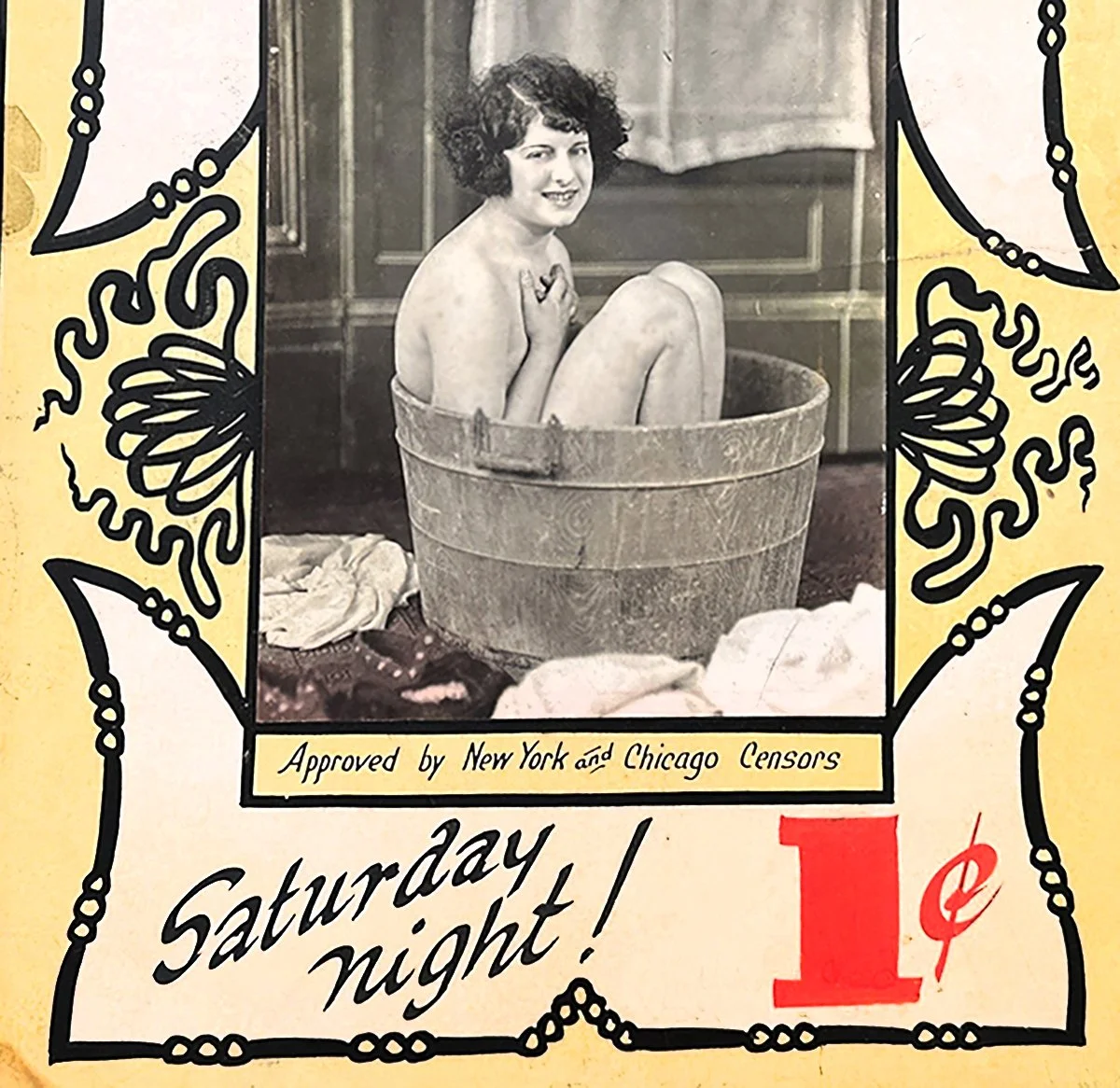Naughty by Nature: The New Orleans Storyville Museum
September 2025The French Quarter’s newest museum examines the city’s notorious red-light district through an entrepreneurial eye.
– by Doug Brantley
Quarter Culture columns are underwritten in part by Tom and Alycia Reagan
One of the things Claus Sadlier likes best is touring the city in his shiny, blue Jeep Cherokee, wrote Mark Seghers for the Times Picayune in 1988.
He enjoys looking at various properties around town and daydreaming that someday he could open a business on this or that lot, in this or that building.
“There’re opportunities everywhere,” he said in his quick, racing way of talking.
Nearly four decades later, Claus Sadlier still speaks at a rapid clip—and his daydreams have become reality.
“I was the teenage nightclub king of New Orleans when I was 21,” he recalls of the article spotlighting the budding businessman’s wildly popular Teasers Teen Clubs. “We’d get 500 to 1,000 kids a night at $4 a head.”
It was just the beginning of a long and multitiered career that includes a finance degree from the University of New Orleans and a MBA from Indiana University, followed by a stint at PepsiCo in San Francisco, where he worked in restaurant development.
As that long-ago newspaper feature foreshadowed, Sadlier would go on to dabble in real estate and tap into his New Orleans-honed entrepreneurial skills to create an innovative, insulated paper coffee cup that he sold to Georgia-Pacific for $170 million, then later Covermate food covers, which he sold to Rubbermaid before returning to his hometown in 2012.
At one year in, his latest endeavor, The New Orleans Storyville Museum, which opened on Conti Street last August, looks to be yet another Sadlier success story.
The Storyville Museum, 1010 Conti Street
Claus Sadlier in the Storyville Museum
Chronicling the city’s legendary red-light district, which sprung up on the outskirts of the Quarter in 1897, in an effort to cordon off and curtail rampant prostitution citywide, the museum also provides an overview of New Orleans history in general—with a focus on its penchant for vice in particular.
Scroll through the Storyville Museum’s 300 five-star Google reviews and you’ll find tourists and locals alike lauding its functional flow and creative design elements as much as its insightful exhibits and supporting ephemera.
“I spent several years going through museums all over Europe, documenting what I felt were really good layouts,” notes Sadlier, “and what I thought were terrible layouts. I got lucky in the fact that it’s easy to tell a story when there’s a timeline.
“I wrote it like a book, then augmented it with the illustrations on the walls and supplemented with artifacts to ground the exhibit.”
Beginning before the city’s own beginning, in 1682 with LaSalle’s claiming of the Louisiana territories for France, the wide-ranging exhibit touches on everything from John Law’s “Mississippi Bubble” (“the biggest Ponzi scheme up until Madoff,” says Sadlier) and the 1721 arrival of the “corrections girls” (the city’s first sex workers), all the way through Storyville’s demolition in 1917.
The first exhibits in the Storyville Museum cover the colonization of Louisiana
One of the opening exhibits in the museum gives a brief overview of the Battle of New Orleans and the role of pirate Jean Jafitte
Years of meticulous research and $1 million-plus out of pocket, Sadlier’s “passion project” has resulted in an impressive collection of items on display, ranging from four 1803 pennies (representing the cost per acre of the Louisiana Purchase) to original Blue Book guides to the city’s brothels, which visitors can browse electronically.
Why such a passion for prostitution?
“I didn’t feel passionate about prostitution,” Sadlier explains. “I felt passionate about providing something for New Orleans that would educate the tourists and really tell the true story of the city.
“I live on Burgundy Street, in the heart of ghost tour territory. I listen to these stories every night and the story is different every time, depending on who tells it.
“But this is real history based on fact, and it’s told in a fun, entertaining fashion. I think ‘edutainment’ is the term for it.”
And “edutaining” it is. Enlightening foundational city history aside, the real draw here is the sex. Sex sells, always has. But the Storyville Museum is hardly as seedy as one might suspect.
An early display on “camp followers,” sex workers who migrated with soldiers downriver, provides a perfect example. A trysting couple inside a tent are cleverly brought to life via a simulated flickering candle casting their silhouetted shadows.
Elsewhere a hologram of a scantily-clad woman animates a replica of an upscale Storyville parlor, while a video vignette provides a cheeky peek inside a working “crib”—barren one-room dens that could be rented for $3 a day.
Possible customers peeping in at museum visitors standing inside a Storyville “crib.”
Why the red lights? One reason is they hide imperfections.
Sadlier commissioned local theater designers to construct the museum’s various sets and worked with the Mid-City-based film production company Fish Pot Studios and area actors on the integrated videos.
Artist and Royal Street gallery owner Jared Osterhold (who attended Brother Martin High School with Sadlier) was brought in to visually recreate the once-thriving Storyville district, which was almost entirely razed during World War I. Today, only three original structures remain.
“His style is exactly what I wanted,” says Sadlier. “I needed a dreamy landscape because it no longer exists.”
Utilizing the city’s 1908 Sanborn Fire Insurance Maps, district directories, and other historic resource materials, Sadlier and his team painstakingly reconstructed Storyville, address by address.
One can browse through historic newspaper reproductions while sitting on the streets of the fancifully recreated Storyville.
Other publications of the day are also on display
There’s “Mayor of Storyville” Tom Anderson’s Arlington Annex Saloon; Josie Arlington’s opulent bordello, The Arlington; Lulu White’s mixed-race Mahogany Hall; and Emma Johnson’s infamous The Studio, which served as basis for Louis Malle’s equally scandalous 1978 film “Pretty Baby.”
In all, at its zenith Storyville covered 14 blocks (bounded by Iberville and St. Louis streets and S. Robertson and Basin streets), and counted 2,200 sex workers, 399 houses of prostitution, 26 saloons and dance halls, three shooting galleries, two churches, one cemetery, and a massive marble train station.
“This story needs to be told,” says Sadlier. “It was a huge commercial enterprise, an incredibly important entrepreneurial community that rivaled the French Quarter in activity that was literally wiped off the map.
“It’s one of the greatest disservices the city has ever done - they actually renamed Basin Street to North Saratoga for a while.”
But, according to Sadlier, the enduring popularity of the “Basin Street Blues” song kept confused tourists asking for directions. Eventually, the city relented and changed the name back to Basin.
Sadlier also tells Storyville’s story through early 1900s peep show machines (a woman ironing in her undergarments!), along with a circa-1880s craps table, vintage roulette wheel, and additional gambling implements, nodding to the city’s 500 licensed casinos at the time. (In comparison, Las Vegas claims just over 300 today.)
Alcohol, absinthe, and opium get their due, as does famed photographer E.J. Bellocq, with a separate gallery devoted to his risqué—and often mundane—depictions of Storyville ladies.
E. J. Bellocq’s portraits of Storyville ladies
One of Bellocq’s ladies of the night during the day.
Compelling historic mug shots invite viewers to wonder about the lives of Storyville’s women.
“But the best documentarians of Storyville were the musicians,” notes Sadlier. “Jazz didn’t start in Storyville, but Storyville was almost certainly an incubator and accelerator for it.
“You had close to 300 musicians working every night. They could practice and experiment and take more liberties than they normally would, because people weren’t necessarily there to hear the music; they were there for other things.”
Visitors can listen to recordings of Jelly Roll Morton
Louis Armstrong, Sydney Bechet, Buddy Bolden, Oscar “Papa” Celestine, Bunk Johnson, Joe “King” Oliver, and Kid Ory are just a smattering of the many musicians and bands that played in and around the district.
Of particular note is Jelly Roll Morton, who regularly performed at Hilma Burt’s brothel and is featured in a seven-minute audio clip culled from 10 hours of interviews he did with the Library of Congress in 1938.
“He talks about the fact that Blacks and whites would mix [when it was illegal to do so] and goes into real detail about it,” adds Sadlier.
There is a lot to take in; visitors will want to devote an hour or more to fully explore all the Storyville Museum offers. And there is yet more to come in the months ahead, with an audio tour in the works, along with guided excursions.
“This neighborhood was steeped in brothels before Storyville opened,” Sadlier notes. “A lot of the buildings around us—including, strangely, the little wedding chapel—were brothels. So, they’ll get a walking tour, then come into the museum for more backstories.”
From 1870 until 1885, the museum’s location itself was part of what was known as “Smoky Row,” a rough-and-tumble section of the Quarter, where more than 100 prostitutes openly plied their trade.
Next to the museum, at 1026 Conti, is photographer Bellocq’s former family home, which later housed the city’s “last madam” Norma Wallace, when prostitution returned to the Quarter soon after Storyville shuttered.
1026 Conti Street, the home of Bellocq and the city’s “Last Madame,” Norma Wallace. Photo courtesy the Vieux Carré Commission Virtual Library
Sadlier has his own familial ties to the area as well.
“My great-great-grandfather owned a drugstore at the corner of Customhouse [now Iberville] and Royal in the late 1800s,” he points out. “I’m sure he probably supplied drugs and things to the brothels.”
Sadlier’s great-grandfather was one of the original trainers at the fabled New Orleans Athletic Club, which was at the gateway to Storyville.
“After my great-grandmother died during childbirth,” Sadlier adds, “he ran off with a 16-year-old from the district, right around the time Storyville opened.
“So…it’s come full circle.”






















